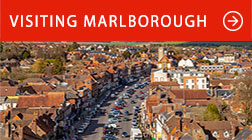
But the Trustees have faced some serious dilemmas and have had to delay the start of public access. They have been confronted with an historic and Grade I Listed building that is not in very good shape – not capable of standing up to the ‘human traffic that would be expected in the case, for example, of National Trust houses’.

One of the Trustees has told marlborough.news that once the work on the roof is finished: “We hope it will be possible (i.e. safe) to allow access to the Manor even though the other building work will take much longer. The building is architecturally fragile so access will have to be in small guided groups.”
The Courtyard Cottages were not ‘wind and watertight’. Once restored they will provide administrative offices, temperature and humidity controlled storage so that paintings now kept in London can be brought back to Ramsbury Manor, and residential accommodation for students. One of Mr Hyams’ aims for the trust – The Capricorn Foundation – was to encourage study of the collection by students.
Once the Manor is open for small supervised groups, new buildings will be created elsewhere on the estate for exhibition spaces fully open to the public and for visitor accommodation.

Harry Hyams bought the 17th century Ramsbury Manor and its estate beside the River Kennet in 1964 for the record sum of £650,000 – now the price of many three-bedroom homes! The Manor was built between 1681 and 1686 by Robert Hooke for the attorney general, Sir William Jones.
The Manor’s art collection contains thousands of items – paintings, furniture, porcelain, silver, statues and a large number of vintage cars. The paintings include famous works by Turner, Millet, Stubbs and Sir Edward Burne-Jones.
Hyams, the son of a bookmaker, made much of his money from developing offices in London in the 1960s and 1970s. These included the landmark Centre Point building at the southern end of Tottenham Court Road, which still lords it over the Central London skyline.
It too became a listed building – being designated Grade II in 1995. It had a chequered history and while it was empty, was occupied by squatters – whom Hyams allowed to stay. Four years ago it was converted into luxury flats.
In his last years Hyams became something of a recluse – keeping himself to himself in Ramsbury Manor, which is conveniently almost totally hidden from public view. His wife had died in 2011.

These paintings from the Ramsbury Manor collection included some gently saucy scenes of Paris life and several of Boilly’s extraordinary Paris street scenes that teem with life and characters of the period of the French Revolution right up to the restoration of the monarchy.
These pictures had never been exhibited before and some had not even been catalogued.
The Trustees have also lent works by Eliot Hodgkin from the ‘significant holding of the artist’s work’ at Ramsbury Manor, to an exhibition in the Coach House Gallery at Waddesdon (home to the Rothschild Collections) near Aylesbury – open until 20 October 2019.
This exhibition of his still life and landscape paintings – Brought to Life: Eliot Hodgkin Rediscovered – also introduces visitors to Ramsbury Manor: ‘Part of the exhibition will be devoted to an introduction to the history of this extraordinary, but very little-known house.’
There is a full and fascinating architectural history of Ramsbury Manor among the documents in the Trustees’ planning application to Wiltshire Council – it can be read here.









